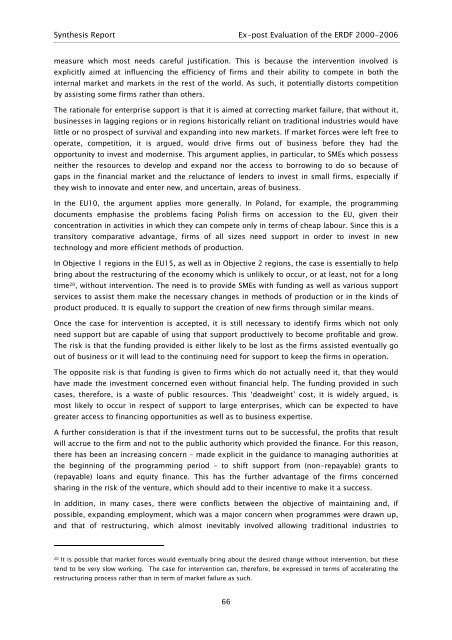Synthesis Report - European Commission - Europa
Synthesis Report - European Commission - Europa
Synthesis Report - European Commission - Europa
You also want an ePaper? Increase the reach of your titles
YUMPU automatically turns print PDFs into web optimized ePapers that Google loves.
<strong>Synthesis</strong> <strong>Report</strong> Ex-post Evaluation of the ERDF 2000-2006<br />
measure which most needs careful justification. This is because the intervention involved is<br />
explicitly aimed at influencing the efficiency of firms and their ability to compete in both the<br />
internal market and markets in the rest of the world. As such, it potentially distorts competition<br />
by assisting some firms rather than others.<br />
The rationale for enterprise support is that it is aimed at correcting market failure, that without it,<br />
businesses in lagging regions or in regions historically reliant on traditional industries would have<br />
little or no prospect of survival and expanding into new markets. If market forces were left free to<br />
operate, competition, it is argued, would drive firms out of business before they had the<br />
opportunity to invest and modernise. This argument applies, in particular, to SMEs which possess<br />
neither the resources to develop and expand nor the access to borrowing to do so because of<br />
gaps in the financial market and the reluctance of lenders to invest in small firms, especially if<br />
they wish to innovate and enter new, and uncertain, areas of business.<br />
In the EU10, the argument applies more generally. In Poland, for example, the programming<br />
documents emphasise the problems facing Polish firms on accession to the EU, given their<br />
concentration in activities in which they can compete only in terms of cheap labour. Since this is a<br />
transitory comparative advantage, firms of all sizes need support in order to invest in new<br />
technology and more efficient methods of production.<br />
In Objective 1 regions in the EU15, as well as in Objective 2 regions, the case is essentially to help<br />
bring about the restructuring of the economy which is unlikely to occur, or at least, not for a long<br />
time 20 , without intervention. The need is to provide SMEs with funding as well as various support<br />
services to assist them make the necessary changes in methods of production or in the kinds of<br />
product produced. It is equally to support the creation of new firms through similar means.<br />
Once the case for intervention is accepted, it is still necessary to identify firms which not only<br />
need support but are capable of using that support productively to become profitable and grow.<br />
The risk is that the funding provided is either likely to be lost as the firms assisted eventually go<br />
out of business or it will lead to the continuing need for support to keep the firms in operation.<br />
The opposite risk is that funding is given to firms which do not actually need it, that they would<br />
have made the investment concerned even without financial help. The funding provided in such<br />
cases, therefore, is a waste of public resources. This ‘deadweight’ cost, it is widely argued, is<br />
most likely to occur in respect of support to large enterprises, which can be expected to have<br />
greater access to financing opportunities as well as to business expertise.<br />
A further consideration is that if the investment turns out to be successful, the profits that result<br />
will accrue to the firm and not to the public authority which provided the finance. For this reason,<br />
there has been an increasing concern – made explicit in the guidance to managing authorities at<br />
the beginning of the programming period – to shift support from (non-repayable) grants to<br />
(repayable) loans and equity finance. This has the further advantage of the firms concerned<br />
sharing in the risk of the venture, which should add to their incentive to make it a success.<br />
In addition, in many cases, there were conflicts between the objective of maintaining and, if<br />
possible, expanding employment, which was a major concern when programmes were drawn up,<br />
and that of restructuring, which almost inevitably involved allowing traditional industries to<br />
20 It is possible that market forces would eventually bring about the desired change without intervention, but these<br />
tend to be very slow working. The case for intervention can, therefore, be expressed in terms of accelerating the<br />
restructuring process rather than in term of market failure as such.<br />
66

















